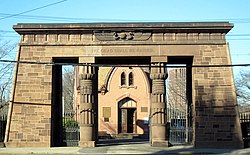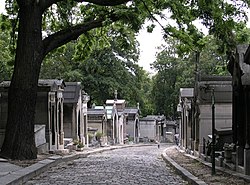Rural cemetery
 From Wikipedia - Reading time: 8 min
From Wikipedia - Reading time: 8 min



A rural cemetery or garden cemetery is a style of cemetery that became popular in the United States and Europe in the mid-19th century due to the overcrowding and health concerns of urban cemeteries, which tended to be churchyards. Rural cemeteries were typically built 1–5 mi (1.6–8.0 km) outside of the city, far enough to be separated from the city, but close enough for visitors. They often contain elaborate monuments, memorials, columbariums and mausoleums in a landscaped park-like setting.[1]
The rural cemetery movement mirrored changing attitudes toward death in the nineteenth century. Images of hope and immortality were popular in rural cemeteries in contrast to the puritanical pessimism depicted in earlier cemeteries. Statues and memorials included depictions of angels and cherubs as well as botanical motifs such as ivy representing memory, oak leaves for immortality, poppies for sleep and acorns for life.[2]
From their inception, the new cemeteries were intended as civic institutions designed for public use. Before the widespread development of public parks, the rural cemetery provided a place for the general public to enjoy outdoor recreation amidst art and sculpture previously available only for the wealthy.[3]
The popularity of rural cemeteries decreased toward the end of the 19th century due to the high cost of maintenance, development of true public parks and perceived disorderliness of appearance arising from independent ownership of family burial plots and different grave markers. Lawn cemeteries became instead an attractive design.
History
[edit]

In the early 19th century, urban burial grounds were generally sectarian and located on small plots and churchyards within cities. With the rapid increase in urban populations due to the Industrial Revolution, urban cemeteries became unhealthily overcrowded with graves stacked upon each other, or emptied and reused for newer burials.[4] The practice of embalming did not become popular until after the Civil War and cemeteries often had the stench of decomposing corpses.[5] After several yellow fever epidemics, many cities began to relocate cemeteries outside city limits, as it was believed to be more hygienic.[6]
As early as 1711, the architect Sir Christopher Wren advocated for the creation of burial grounds on the outskirts of town, "inclosed with a strong Brick Wall, and having a walk round, and two cross walks, decently planted with Yew-trees".[7]
An early influence on the Rural Cemetery movement was the New Burying Ground in New Haven, Connecticut (later named Grove Street Cemetery). The New Burying Ground was established in 1796, and was the first example in the U.S. of a non-sectarian cemetery outside of church and city control in a park-like setting.
In 1804, the first rural cemetery, the Père Lachaise Cemetery, opened in Paris. The new design took the cemetery out of the control of the church, using an attractive park built on a grand scale, architectural design and careful planting inspired by the English garden movement.[8]
United States
[edit]

The first rural cemetery in the United States was Mount Auburn Cemetery in Cambridge, Massachusetts, founded by Dr. Jacob Bigelow and Henry Dearborn of The Massachusetts Horticultural Society in 1831. The City of Boston became concerned about the health hazards caused by decomposing corpses in cemeteries in the middle of the city. A citizens' group led by Bigelow pulled together residents to discuss the design and location of a cemetery outside city limits. The search for a site took six years and land was eventually purchased on a farm known as Sweet Auburn along the Charles River about four miles from Boston.[9]
Coinciding with the growing popularity of horticulture and the Romantic aesthetic taste for pastoral beauty, Mount Auburn was developed as a "domesticated landscape" popularized by 19th century English landscape design. Its plan included retention of natural features like ponds and mature forests with added roads and paths that followed the natural contours of the land, as well as the planting of hundreds of native and exotic trees and plants.[10] United States Supreme Court Justice Joseph Story delivered the dedication address on September 24, 1831.
Mount Auburn also began the practice of allowing the purchase of family plots large enough to allow the burial of several generations of a single family.[11]
Mount Auburn quickly grew as a popular site for both burials and public recreation, attracting locals as well as tourists from across the country and Europe. Mount Auburn inspired dozens of other rural cemeteries across the U.S. such as Laurel Hill Cemetery in Philadelphia, and Green-wood Cemetery in Brooklyn.[8] Many were accompanied by dedication addresses similar to Storys', which linked the cemeteries to the mission of creating a Christian republic.[12]

In 1847, the New York State Legislature passed the Rural Cemetery Act which authorized commercial burial grounds in New York. The law led to the burial of human remains becoming a commercial business for the first time, replacing the practice of burying the dead in churchyards or on private farmland. One effect of the law was the development of a large concentration of cemeteries along the border between the New York City boroughs of Queens and Brooklyn, often called the "Cemetery Belt".[13]
By the 1860s, rural cemeteries could be found on the outskirts of cities and smaller towns across the country.[14] These cemeteries were decorated with tall obelisks, spectacular mausoleums, and magnificent sculptures.[15]
By 1861, the rural cemetery movement began to decline partly due to the high cost of maintaining large landscapes but also due to the development of public parks. Many landscape designers, including Frederick Law Olmsted who designed Central Park in New York City, borrowed ideas from rural cemeteries. As more public parks opened, fewer people went to cemeteries for leisure and relaxation activities.[16]

Due to the scale of death caused by the American Civil War (almost 2% the U.S. population died in the war), the U.S. government outsourced many burials to privately owned rural cemeteries.[17]
Since family plot owners could do as they wished with their lots, rural cemeteries that began as orderly and scenic ended up as cluttered and unkempt.[18] Rural cemeteries began to fade out of popularity and were replaced by the lawn cemetery.[19]
Presently, many of these historic cemeteries are designated landmarks and are cared for by non-profit organizations.
Canada
[edit]
- Mount Hermon Cemetery in Sillery, Québec City (1848)
David Bates Douglass, a military and civilian engineer, working in the capacity as a consulting architect, designed the landscape layout of Albany Rural Cemetery, 1845–1846. He modeled his design of the Albany Rural Cemetery, as well as his subsequent and final one, Mount Hermon Cemetery (1848), in a rural area outside of Quebec City, Canada, upon his first design, the highly acclaimed Green-Wood Cemetery, in what at the time was a rural section of Brooklyn. All three of Douglass' rural, garden cemeteries have been conferred a historic status, by their respective nations.[20][21]
- Cimetière Notre-Dame-des-Neiges in Montreal (1852);
- Cimetière Notre-Dame-de-Belmont in Sainte-Foy, Québec City (1857–1859)
Its architect, Charles Baillargé, took inspiration from Green–Wood Cemetery, as well, for his design of this garden cemetery, in what at the time was the rural outskirts of the city of Québec.[22]
England
[edit]
The development of the American movement paralleled the creation of the landscaped cemeteries in England, with Mount Auburn inspiring the design of London's first non-denominational cemetery at Abney Park (1840), one of the Magnificent Seven cemeteries.
- Kensal Green Cemetery in London (1833)
Germany
[edit]Among the first of the Parkfriedhof established in German-speaking Europe, the South Cemetery (Südfriedhof) in Kiel dates from 1869, the Riensberger Friedhof in Bremen dates from 1875, the 1881 Zentralfriedhof Friedrichsfelde in Berlin, the 1881 Südfriedhof in Leipzig, and the Ohlsdorf Cemetery in Hamburg. The Ohlsdorf was transformed from a treeless, sandy plain into 92 acres of sculpted, wooded landscape by its first director, architect Wilhelm Cordes.[23] In 2016 it stands as the largest rural cemetery in the world,[24] and has been the largest cemetery in Europe since its opening in 1875.
As of 1911,[update] rural cemeteries were still unusual in Germany.[23] Other examples include the Waldfriedhof Dahlem in Berlin, 1931.
See also
[edit]References
[edit]- ^ Smith, Jeffrey (2017). The Rural Cemetery Movement: Places of Paradox in Nineteenth Century America. Lexington Books. ISBN 978-1498529006.
- ^ Greene, Meg (2008). Rest in Peace: A History of American Cemeteries. Lerner Publishing Group, Inc. p. 36. ISBN 978-0822534143.
- ^ Douglas, Ann, The Feminization of American Culture, 1977, New York, Alfred A. Knopf, pp. 208–213.
- ^ Greenfield, Rebecca (16 March 2011). "Our First Public Parks: The Forgotten History of Cemeteries". U.S. The Atlantic. Retrieved 16 September 2019.
- ^ Greene 2008, p. 31
- ^ Warren, Abby (19 October 2015). "Indian Hill, Unearthed: A Cemetery's Roots". The Wesleyan Argus. Middletown, Conn.: Wesleyan University. OCLC 905545962. Retrieved 16 September 2019.
- ^ Chambers, S. Allen (June 2004). "Let the stones speak, the spire and crypt inspire: A history of St Mary's church, Islington". StMaryIslington.org. Archived from the original on 14 August 2007.
It will be enquired, where then shall be the Burials? I answer, in Cemeteries seated in the Out-skirts of the Town... This being inclosed with a strong Brick Wall, and having a Walk round, and two cross Walks, decently planted with Yew-trees, the four Quarters may serve four Parishes, where the Dead need not be disturbed at the Pleasure of the Sexton, or piled four or five upon one another, or Bones thrown out to gain Room. Letter of advice to the Commissioners for Building Fifty New City Churches in 1711.
- ^ a b "1833–1875: Rural Cemetery Movement". PHMC Cemetery Preservation and Recordation. 26 August 2015. Retrieved 16 September 2019 – via Pennsylvania Historical and Museum Commission.
- ^ Greene 2008, p. 31
- ^ National Park Service Historic Landscape Initiative; Heywood, Janet; Lambert Breitkreutz, Cathleen. West, Jean (ed.). "Teaching with Historic Places Lesson Plans. Mount Auburn Cemetery: A New American Landscape". NPS.gov. Archived from the original on February 10, 2008. Retrieved 16 September 2019.
- ^ Greene 2008, p. 32
- ^ Brophy, Alfred L. (12 August 2013). "'These Great and Beautiful Republics of the Dead': Public Constitutionalism and the Antebellum Cemetery". Legal Scholarship Network: Legal Studies Research Paper Series, University of North Carolina. Rochester, NY: Social Science Electronic Pub. doi:10.2139/ssrn.2304305. LCCN 2011219039. OCLC 7374605598. Retrieved 16 September 2019.
- ^ Williams, Keith (27 April 2017). "Why the Brooklyn-Queens Border is Full of Dead People". F.Y.I. The New York Times. ISSN 1553-8095. OCLC 819006198. Retrieved 16 September 2019.
- ^ Yalom, Marilyn (2008). The American Resting Place: Four Hundred Years of History Through Our Cemeteries and Burial Grounds. Houghton Mifflin Harcourt. p. 46. ISBN 978-0618624270.
- ^ Yalom 2008, p. 102
- ^ Greene 2008, pp. 40–41
- ^ Smith 2017, pp. 7–8
- ^ Greene 2008, p. 40
- ^ Greene 2008, pp. 42–43
- ^ Cox, Rob S.; Heslip, Philip; LaPlant, Katie D. (July 2017) [1812]. Finding aid for David Bates Douglass Papers, 1812–1873 (1,191 items). M-1390, M-2294, M-2418, M-2668, M-5038, M-6083. David Bates Douglass. Ann Arbor. Retrieved 2018-11-02.
Returning to engineering and consulting work, Douglass laid out the Albany Rural Cemetery in 1845–46 and the Protestant cemetery in Quebec in 1848, both in the style of Greenwood Cemetery. In August 1848, he moved to Geneva College (now Hobart).
{{cite book}}:|work=ignored (help)CS1 maint: location missing publisher (link) - ^ "David Bates Douglass – Related Content – The Cultural Landscape Foundation". tclf.org. Retrieved 2018-11-02.
- ^ "Historique du cimetière – Cimetière Notre-Dame-de-Belmont". CimetiereBelmont.ca (in Canadian French). Retrieved 2018-12-03.
- ^ a b "Modern Landscape Cemeteries in Germany", Park & Cemetery and Landscape Gardening, Vol XXI No. 9, November 1911, pages 704–705
- ^ "Hamburg Cemetery | Cemetery Details | CWGC".
Further reading
[edit]- Linden, Blanche M.G. (2007). Silent City on a Hill: Picturesque Landscapes of Memory and Boston's Mount Auburn Cemetery. University of Massachusetts Press. ISBN 978-1558495715.
 KSF
KSF